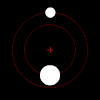(66063) 1998 RO1
Synodic rotation period | 2.4924±0.0003 h[4] 2.4924 h[5][9] | |
| 0.145[9] 0.30±0.17[7] | ||
| S[10][11][12] | ||
| 18.00[12] · 18.04[9] · 18.05[10] · 18.05±0.071[13] · 18.1[1] | ||
(66063) 1998 RO1 is a stony
Its minor-planet moon, provisionally designated S/2001 (66063) 1, was discovered in September 2003. It has an orbital period of 14.53 hours and measures approximately 48% of its primary, or 380 meters.[1][3] It is one of seven known Aten binaries as of 2017.
Interaction with Earth
1998 RO1's orbit is very eccentric, with an
Moon

1998 RO1 has one moon, S/2001 (66063) 1. This moon was discovered from lightcurve observations going from 13 to 28 September 2013, and was confirmed by radar observations from the Arecibo Observatory one year later. It is in a very close orbit to 1998 RO1, with a semi-major axis of 800 m (2,600 ft) and an eccentricity of 0.06,[3] giving it a periapsis of 752 m (2,467 ft) and an apoapsis of 848 m (2,782 ft). S/2001 (66063) 1 takes 14.54 hours to complete one orbit around 1998 RO1.[3]
From the surface of 1998 RO1, S/2001 (66063) 1 would have an apparent diameter of roughly 41°.[a] For comparison, the Sun appears to be 0.5° from Earth. The secondary orbits its primary in a manner very similar to the adjunct image, where the red cross is the center of mass.
Numbering and naming
This
Notes
- ^ Calculated by solving .
References
- ^ a b c d e f g "JPL Small-Body Database Browser: 66063 (1998 RO1)" (2010-09-10 last obs.). Jet Propulsion Laboratory. Retrieved 18 November 2017.
- ^ a b c "66063 (1998 RO1)". Minor Planet Center. Retrieved 18 November 2017.
- ^ a b c d e f Johnston, Wm. Robert (20 September 2014). "Asteroids with Satellites Database – (66063) 1998 RO1". Johnston's Archive. Retrieved 18 November 2017.
- ^ Bibcode:2004CoSka..34..157G.
- ^ Bibcode:2003IAUC.8216....3P.
- ^ .
- ^ .
- ^ "Asteroid Size Estimator". CNEOS NASA/JPL. Retrieved 18 November 2017.
- ^ .
- ^ a b c "LCDB Data for (66063)". Asteroid Lightcurve Database (LCDB). Retrieved 18 November 2017.
- Bibcode:2005LPI....36.2283A.
- ^ S2CID 119258489.
- .
- ^ "MPC/MPO/MPS Archive". Minor Planet Center. Retrieved 24 February 2018.
External links
- Binary and Ternary Near-Earth Asteroids Detected by Radar, Lance Benner, JPL
- Asteroids with Satellites, Robert Johnston, johnstonsarchive.net
- Asteroid Lightcurve Database (LCDB), query form (info Archived 16 December 2017 at the Wayback Machine)
- Asteroids and comets rotation curves, CdR – Observatoire de Genève, Raoul Behrend
- (66063) 1998 RO1 at NeoDyS-2, Near Earth Objects—Dynamic Site
- (66063) 1998 RO1 at ESA–space situational awareness
- (66063) 1998 RO1 at the JPL Small-Body Database

